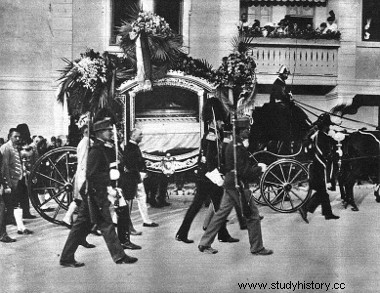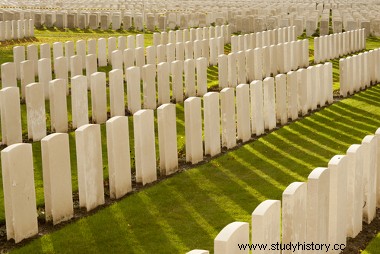
By Me. Cláudio Fernandes
The First World War , which lasted from 1914 to 1918, was considered by many of its contemporaries as the most terrible of wars. For this reason, it became known for a long time as “The Great War”. In order to understand the reasons why it was such a long and catastrophic war, it is necessary to recall some aspects of the world political and economic scenario in the last decades of the 19th century.
In the second half of the 19th century, the junction between financial capitalism and industrial capitalism provided the world economic integration, thus favoring, mainly, the nations that had started their industrialization process. These same nations significantly expanded their territory towards other continents, especially Asia, Africa and Oceania. England, for example, integrated large countries into its Empire, such as India and Australia. This whole process is conceptually treated by historians as Imperialism and Neocolonialism. In this scenario, the main problems that culminated in the world conflict were unleashed.
In the early 1870s, Germany was promoting its unification with Prussia and, at the same time, facing France in what became known as the Franco-Prussian War. By beating France, Germany was able to take possession of a region rich in iron ore, which was very important for the development of its industry, including the war industry. This was the region of Alsace and Lorraine. France, in the decade after the war against Germany, developed a strong feeling of revenge, which caused enormous tension on the border between the two countries. Tensions escalated when Otto von Bismarck, the leader of German unification, established an alliance with Austria-Hungary and Italy, which became known as the Triple Alliance . This alliance established both commercial and financial agreements as well as military agreements.
France, which saw itself progressively threatened by the influence that was established by Germany, began to sign agreements, similar to the Triple Alliance, with the tsarist Russian Empire in 1894. England, which was one of the largest empires of the time and also protected itself from the German advance and feared suffering losses of territory and economic blockades, ended up allied with France and Russia, thus forming the Triple Entente .
Tension between the two alliances has become increasing, specifically in some regions such as the Balkan peninsula. In the Balkan region, two great empires struggled to impose a nationalist hue rule:Austro-Hungarian and Russian. Russia sought to expand its Slavic nationalist ideology (known as Pan-Slavism) and supported the creation, in the Balkans, of the state of Greater Serbia, while Austria-Hungary took advantage of the fragility of the Turkish-Ottoman Empire (which dominated this region during for a long time) and sought, with the help of Germany, to establish control in the same region, also using a nationalist ideology (known as Pan-Germanism). In 1908, the region of Bosnia-Herzegovina was annexed by Austria-Hungary, which made it difficult to create “Greater Serbia”. Furthermore, Germany had commercial interests in the Middle East, especially in the Persian Gulf, and intended to build a railway from Berlin to Baghdad, via the Balkan Peninsula.
The trigger for the conflict between the two great forces that were concentrated in the Balcons region came with the assassination of Archduke Franz Ferdinand , heir to the throne of Austria-Hungary, by a militant of the terrorist organization Black Hand , with a Slavic nationalist bias. The Archduke's assassination took place on January 28, 1914, in Sarajevo, the capital of Bosnia. Franz Ferdinand had gone to Sarajevo with a proposal to create a triple monarchy for the region, which would be ruled by Austrians, Hungarians and Slavs. His death stirred up nationalist tempers and led the alliances of the main European powers to war.

The assassination of Franz Ferdinand, heir to the throne of Austria-Hungary, in the city of Sarajevo, was considered the trigger of the First World War
2
Austria saw in this fateful event the opportunity to attack Serbia and demolish the Slavic project to build a strong state. Thus, Austria-Hungary and Germany gave Serbia an ultimatum to solve the Franz Ferdinand murder case. Serbia refused to give in to pressure from the Germans and, with the support of Russia, its ally, prepared for what came next:the declaration of war by Austria-Hungary, which was formalized on 28 July. 1914. Soon France offered support to Russia against Austria-Hungary, which caused Germany to declare war on Russia and France. The conflict soon expanded to other regions of the globe.
The war intensified when the German army, which was the most modern at the time, headed towards France, passing through Belgian territory, which was neutral. This caused England, an ally of Russia, to declare war on Germany. From that moment onwards, the war took on increasingly catastrophic proportions. The main forms of military tactics were trench warfare, or positional warfare, which aimed to protect conquered territories; and the war of movement, or advancing positions, which was more offensive and had heavy weapons and equipped infantry.
Throughout the war, the use of new weapons, perfected by industry, combined with new inventions such as the plane and tanks, gave combat a characteristic of powerlessness on the part of soldiers. Thousands of men died instantly in bombings or enveloped in immense clouds of toxic gas. This characteristic had a high impact on the imagination of generations following the war. Writers such as Erich Maria Remarque, Ernst Jünger and J. J. R. Tolkien, who fought in World War I, drew many elements from her to compose their stories.
The year 1917 was decisive in the context of the “Great War”. That year, Russia withdrew from the battlefront, as its army was obsolete and its economy in ruins. It was also in this year that the Bolshevik revolutionaries carried out their communist revolution in Russia, a crucial fact for the European political effervescence of the following decades. It was still in 1917 that the United States entered the war on the side of England and France and against Germany, which no longer had the same strength at the beginning of the war. Since, after the end of the First World War in 1918, the United States became the great power outside the European continent.
The “Great War” came to an end in 1918, with a victory for France's allies and a great defeat for Germany. The most important point to highlight regarding the end of the war are the provisions of the Treaty of Versailles . In these determinations, the winning countries did not accept the guidance of the League of Nations of not subjecting defeated Germany to compensation for the damages of the war. Thus, Germany was forced to cede territories and reorganize its economy taking into account the future reimbursement to the victorious countries of the First War, especially France.
The death toll during the five years of World War I was a total of 8 million, of which 1,800,000 were Germans alone. This type of accelerated and terribly impacting death was repeated after 1939, with the Second World War.

The First World War left a huge number of soldiers dead for all the nations involved, in addition to the vast destruction in European cities
The imagery of the First World War populates the territories of various arts. In cinema, for example, we have numerous films that thematize it. Two of them are worth mentioning:“Hearts of the World” (1918), by Griffith, still produced “under the heat of war” and “Glory Made of Blood” (1957), by Stanley Kubrick.
__________________________
*Image credits:
1
Wikimedia Commons / National Library NZ on The Commons
2
Wikimedia Commons
Take the opportunity to check out our video lesson on the subject:
